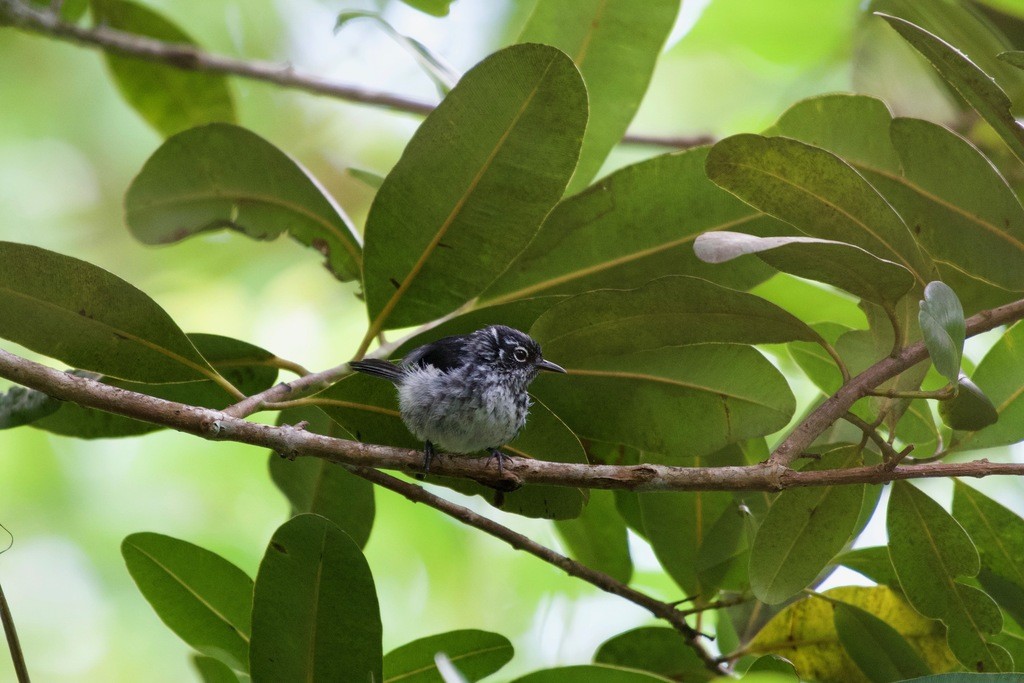Elfin-woods Warbler
A species of Setophaga Warblers Scientific name : Setophaga angelae Genus : Setophaga Warblers
Elfin-woods Warbler, A species of Setophaga Warblers
Botanical name: Setophaga angelae
Genus: Setophaga Warblers
Content
Description General Info
 Photo By christian_nunes , used under CC-BY-NC-4.0 /Cropped and compressed from original
Photo By christian_nunes , used under CC-BY-NC-4.0 /Cropped and compressed from original Description
The elfin woods warbler is a small passerine, averaging 12.5 cm (5 in) in length and 8.4 g (0.30 oz) in weight. Its upperparts are predominantly black with white areas, and its underparts are white with black streaks. Other identifying characteristics are dark brown eyes, white patches on its ears and neck, an incomplete white eyering, a white eyestripe, and two white spots on its outer tail feathers. Like other Antillean warblers (Adelaide's warbler, Saint Lucia warbler, plumbeous warbler, and arrowhead warbler), it has a long bill and short, round wings (53.8 mm or 2.12 in average). Among Setophaga species, only Adelaide's warbler has a shorter average wing length. Juveniles differ from adults, retaining a grayish-green back for approximately a year and partially molting from July to October. 
Size
13 cm
Nest Placement
Shrub
Feeding Habits
Elfin-woods Warbler predominantly feeds on arboreal arthropods and insects, exhibiting foraging behaviors within the canopy. Specialized in flitting through dense foliage to catch prey, elfin-woods Warbler displays unique adaptability to its montane forest habitat.
Habitat
Elfin-woods Warbler thrives in mountainous, moist habitats at higher elevations, chiefly within Elfin, Palo Colorado, and Podocarpus forests. These birds favor humid, mature forests and show a marked decline in altered landscapes like plantations and secondary forests. Their habitat excludes drier forest types, underscoring a specialized preference for specific environmental conditions.
Dite type
Insectivorous
General Info
Feeding Habits
Bird food type
Distribution Area
When first discovered, the elfin woods warbler was believed to exclusively occur in the high elevation, from 640 to 1,030 meters (2,100 to 3,380 ft), dwarf or elfin forests of the El Yunque National Forest in eastern Puerto Rico. The wind-clipped trees in these forests rarely exceed 5 meters (16 ft) in height and are characterized by stiff, thick twigs, leathery leaves and impenetrable, dense undergrowth ideal for hiding from predators. Later studies showed that the species migrated to lower elevations, between 370 and 600 meters (1,210 and 1,970 ft), in Tabonuco and Palo Colorado forests. Three more populations were discovered in the Maricao State Forest (1972, largest known population), the Carite State Forest (1977) and the Toro Negro State Forest (late 1970s). The species is presumed extirpated from two locales, occurring only at El Yunque National Forest and the Maricao State Forest. The elfin forest at El Yunque National Forest is characterized by high rainfall and humidity, low temperatures and insolation, and constant winds. It is found at mountain summits and is primarily composed of dense shrub and small trees with moss and epiphyte growth in its plants and floor. The species richness is low when compared to other types of forests (tabonuco, palo Colorado and palma sierra forests) found in the Luquillo Mountains. The elfin forest at the Maricao State Forest, located in western Puerto Rico, receives an annual average rainfall of 2,250 millimeters (90 in), a high amount considering that a rainforest, by definition, receives a minimum of 1,700 millimeters (67 in) annually. Since its soil has low water-holding capacity its vegetation is more xeric than expected. The species's highest density occurs in Podocarpus forests in the Maricao State Forest. Little information is available on the elfin forests at Toro Negro and Carite. 
Species Status
The elfin woods warbler faces two main threats: predation, and the destruction or alteration of suitable habitat. The pearly-eyed thrasher, the Puerto Rican sharp-shinned hawk and the now extirpated white-necked crow are all confirmed native predators. Unconfirmed but potential native predators include two endemic snakes and several carnivores known from fossil records. Introduced species, such as domestic cats and dogs, black rats, and small Asian mongooses, are also potential nest predators. These introduced species have proliferated in the Maricao State Forest and El Yunque National Forest due to the presence of facilities built mainly for communication purposes. Both natural and human factors contribute to the destruction of the elfin woods warbler's habitat. The construction of communication towers, logging, and the expansion of roads and trails have all caused habitat destruction within the warbler's range. Natural disasters such as forest fires and hurricanes have also decimated habitat. 
Scientific Classification
Phylum
Chordates Class
Birds Order
Perching birds Family
New world warblers Genus
Setophaga Warblers Species
Elfin-woods Warbler